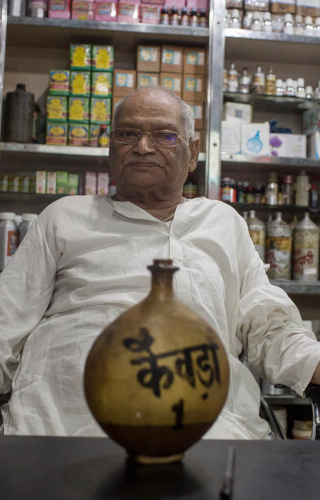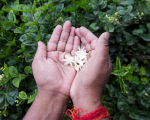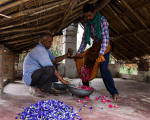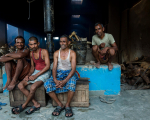As a photographer, I have always been interested in how things are made. I have been fascinated by how raw materials are skilfully transformed in the hands of expert craftsmen to form products of great beauty and utility. In India, other than entirely handmade products, crafts are also produced in a semi-industrialised manner in factories. With the central government promoting ‘Make in India’, I wanted to go behind the scenes to document how that vision is unfolding at ground zero. I was curious to explore ‘smell’ as an often overlooked sensory subject. In India, olfactory gratification is crafted at an industrial scale at Kannauj, in Uttar Pradesh, which is where I headed.
Perfume making has a long history in India. The Mahajanapada kingdom of Gandhara (in present-day Peshawar) took its name from the root word ‘gandha’, meaning aroma, because the region was once renowned for its perfume makers, who made fragrances from aromatic herbs, flowers and spices. Kannauj was the ancient capital of powerful empires in North India and perfume making here go back to the time of Emperor Harshavardhan (r. 606–47 CE). Traders in Kannauj also evoke a story about Mughal Empress Nur Jahan: when she emerged from a hammam (Turkish bath) smelling of roses, a court physician investigated the cause and discovered hot water had an aroma dispersion effect, and he subsequently designed the traditional pot/vat called deg. This story is surely apocryphal, but a similar process had indeed been developed much earlier by the Persian polymath Avicenna (Ibn Sena), in the late ninth or early tenth century, when he used steam distillation to produce essential oils from roses.
Most perfume shops in Kannauj are concentrated around Safdarganj, Subzi Mandi Road and Farsh Street, in the heart of the city. I met Mr Shakti Vinay Shukla, Director at the Fragrance and Flavour Development Centre (FFDC), who explained to me the dynamics of the modern perfume industry. FFDC was established by the government in 1991, and it is involved in a variety of activities to promote and scale up the perfume industry in Kannauj.
At FFDC, I realised how ubiquitous fragrances are in our daily lives. The perfume industry at Kannauj produce fragrances used in a range of home products, such as shampoos, toothpaste, detergents, hair oil, talcum powder, soap, room freshener, etc., and flavours used in food and beverages, such as ice-cream, chewing gum, sherbet, soft drinks, confectionary products, etc.
With the passing of time, usage in other products like snuff, pan masala, etc., came about. According to Mr Shukla, the perfume business was badly hit by the gutkha ban, as 95 per cent of the domestic usage was in creating various gutkha flavours. A new emerging market includes products related to aromatherapy, but it still hasn’t found its foot in Kannauj, with oils used for aromatherapy accounting to less than 0.5 per cent volume in usage.
Regardless of the increasing range of new applications, Kannauj is renowned specifically for ittar (also pronounced attar or itr) making. The delicate whiff of ittar is like an aromatic signature, which lingers long after a person has exited a space. In earlier days, perfumers crafted custom-made fragrances according to the personality and preferences of a client. Composing a perfume is a complex science and integrates in-depth knowledge of subjects like organic chemistry, botany and pharmacy. A perfumer who is briefed with designing a new perfume approaches the composition like a musical piece, with top, middle and base notes. It takes years of apprenticeship for a perfumer to develop a keen sense of smell and to capture the ‘experience’ of a smell. Due to its complexity and exactness, perfumers pass down formulas as a closely guarded secret through generations in the same family. Some families in Kannauj claim to have been in the perfume-making industry for 30 generations!
The perfume industry uses various types of herbs and flowers (jasmine, lavender, rose, clove, pandanus) as the main base for extracting essential oils. Essential oils can also be extracted from a wide variety of natural substances like bark (cinnamon, cassia), berries (juniper, allspice), leaves (basil, eucalyptus, pine, rosemary, vetiver, lemon grass), peel (lemon, lime, orange, tangerine), resin (frankincense, labdanum, myrrh), rhizome (ginger), seeds (nutmeg, flax) and wood (agarwood, camphor, rosewood, sandalwood). Some of these are sourced locally, and the rest are imported from other states. Earlier ittars were also made of animal extract like musk (musk deer, civet) and ambergris (sperm whale), though these have been replaced by synthetic alternatives, since many of these animals are now protected species.
I visited Pragati Aroma Factory to experience the hydro-distillation process. The process itself is rather straightforward but the factory environment was fascinating with its interplay of light, shadows and human labour. The first step involves plucking and sorting of flowers, usually done early in the morning. The flowers must be distilled the same day, before the natural fragrance fades away. They are poured into copper vats (degs), which are sealed with a kind of smooth black mud. A kamani (plate) is added on top of the deg and locked by a wooden log (phaniya) to tightly seal the lid. Each deg is permanently fixed over an open furnace fired with dung cakes or wood. During steaming, fumes (bhap) pass through bamboo pipes (chonga) and are condensed in pots (bhapkas) that are water cooled. No electricity is used in the factory and the hot and humid environment makes it a very oppressive place to work. The extreme temperatures in the furnaces heated up my cameras, causing them to malfunction and difficult to hold at times.
Subsequently, after six to eight hours of leaving the degs overnight, they are opened. The bhapkas are removed from the sinks and the distilled liquid is collected and slow heated in a second set of degs till all the residual moisture evaporates and only pure oil is left behind. The entire distillation process is eco-friendly, and there is minimal wastage. The waste inside the deg is collected and recycled for making agarbatti and dhoop.
Next, the oil collected from the bhakpas is aged in specially made flasks called kuppis. The kuppis are made of goat or camel leather. The leather absorbs any extra moisture, allowing water to evaporate and only ittar, in its truest scent, to remain. The aging period can last from one to 10 years, depending on the botanicals used and the results desired. The oil is then tested and categorised. Ittars are classified based on their perceived effect on the body. ‘Warm’ ittars such as musk, amber and kesar (saffron) are used in winter, as they are believed to increase body temperature. Likewise, ‘cool’ ittars such as rose, jasmine, khus (vetiver), kewra (pandanus) and mogra (jasmine) are used in summer, for their perceived cooling effect on the body. Unlike modern deodorants and body sprays, the perfumes made in Kannauj do not use any alcohol and have no side effects on the skin.
Pricing is dependent, first and foremost, on the type of base oil. Though renowned for its sandalwood perfumes, currently only 1 per cent of manufacturers in Kannauj use sandalwood base. Sandalwood usage has dwindled due to government restrictions on logging, and the growing popularity of synthetic base (liquid paraffin). Each formula has a unique base cost and an additional bottling cost. Designer bottling can raise the final cost significantly, depending on size, material and design. The bottling, packaging and branding is done in-house. Surprisingly, of the total oil produce, only 5 per cent is sold in India, 20 per cent is used for making dhoop, agarbatti, and in other functional and cosmetic usage, and the significant majority, around 75 per cent, is exported, mainly to countries in the Middle-East.
Unfortunately, modern Kannauj has retained no visual memory of its glorious history. The only continuity with its past is through the memory of smell, and that has remained unchanged for centuries. During my visit, I also realised that the perfume industry at Kannauj sustains symbiotic industries like kuppi making and ittardan (glass bottles for selling ittar) manufacturing. These are distinct craft forms in themselves. Changes in the demand and supply of one affects the rest. In the future, I would love to return to Kannauj again to document these industries individually.
















